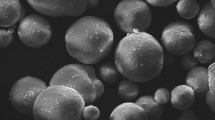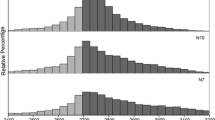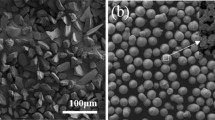Abstract
It is generally known that the porosity of thermal barrier coatings is essential to guarantee a sufficiently high strain tolerance of the coating during thermal cycling. However, much less is known about the influence of the specific morphology of porosity, such as microcracks and typically larger pores, on the performance of the coatings. Both features are usually formed during plasma spraying of yttria-stabilized zirconia (YSZ) thermal barrier coatings (TBCs). In this investigation, the influence of microcracks on the thermal cycling behavior was studied. The amount of microcracks within YSZ thermal barrier coatings was changed by changing the powder-feeding rate. Only small changes of the total porosity were observed. Mercury porosimetry served as a tool to investigate both the amount of microcracks and pores in the coating. Additionally, microcrack densities were determined from metallographical investigations. A linear dependence between the amount of fine pores determined by Hg porosimetry and the crack density was obtained for one set of coatings. Thermal cycling TBC specimens with different microcrack densities were produced and tested in a gas burner test facility. At high surface temperatures (above 1300 °C), failure occurred in the ceramic close to the surface. Under these conditions, the samples with increased horizontal microcrack densities showed a significant increase of thermal cycling life.
Similar content being viewed by others
References
S. Stecura: “Optimization of the Ni-Cr-Al-Y/ZrO2-Y2O3 Thermal Barrier System,” Adv. Ceram. Mater., 1986, 1(1), pp. 68–76.
P. Bengtsson, T. Ericsson, and J. Wigren: “Thermal Shock Testing of Burner Cans Coated with a Thick Thermal Barrier Coating,” J. Therm. Spray Technol., 1998, 7(3), pp. 340–48.
Z.Z. Mutasim and Y.L. Nava: “Development and Performance of Thick Air Plasma Sprayed Thermal Barrier Coatings,” in Thermal Spray: Surface Engineering via Applied Research, C.C. Berndt, ed., ASM International, Materials Park, OH, 2000, pp. 1325–30.
R. Vaßen, G. Kerkhoff, and D. Stöver: “Development of a Micromechanical Life Prediction Model for Plasma Sprayed Thermal Barrier Coatings,” Mater. Sci. Eng., 2001, A303(1–2), pp. 100–09.
R. Vaßen, G. Barbezat, and D. Stöver: “Comparison of Thermal Cycling Life of YSZ and La2Zr2O2-Based Thermal Barrier Coatings,” in Materials for Advanced Power Engineering 2002, J. Lecomte-Becker, M. Carton, F. Schubert, and P.J. Ennis, ed., Schriften des Forschungszentrum Jülich, Reihe Energietechnik, Jülich, Germany, Vol. 21, Part 1, 2002, pp. 511–21.
R. Vaßen, N. Czech, W. Malléner, W. Stamm, and D. Stöver: “Influence of Impurity Content and Porosity of Plasma Sprayed Yttria Stabilised Zirconia Layers on the Sintering Behaviour,” Surf. Coat. Technol., 2001, 141, pp. 135–40.
R.A. Miller, J.L Smialek, and R.G. Garlick: “Phase Stability in Plasma-Sprayed Partially Stabilized Zirconia-Yttria,” in Science and Technology of Zirconia, Advances in Ceramics, Vol. 3, A.H. Heuer and L.W. Hobbs, ed., The American Ceramic Society, Columbus, OH, 1981, pp. 241–51.
P. Bengston and T. Johannesson: “Characterization of Microstructural Defects in Plasma-Sprayed Thermal Barrier Coatings,” J. Therm. Spray Technol., 1995, 4(3), pp. 245–51.
P. Bengston and J. Wigren: “Segmentation Cracks in Plasma-Sprayed Thick Thermal Barrier Coatings,” in Gas Turbine Materials Technology, P.J. Maziasz and I.G. Wright, ed., ASM International, Materials Park, OH, 1999, pp. 92–101.
J. Wigren, J.-F. de Vries, and D. Greving: “Effects of Powder Morphology, Microstructure, and Residual Stresses on Thermal Barrier Coating Thermal Shock Performance,” in Thermal Spray: Practical Solutions for Engineering Problems, C.C. Berndt, ed., ASM International, Materials Park, OH, 1996, pp. 855–61.
J.A. Thompson and T.W. Clyne: “The Effect of Heat Treatment on the Stiffness of Zirconia Top Coats in Plasma-Sprayed TBCs,” Acta. Mater., 2001, 49, pp. 1565–75.
M. Ahrens, S. Lampenscherf, R. Vaßen, and D. Stöver: “Sintering and Creep Processes in Plasma-Sprayed Thermal Barrier Coatings,” J. Therm. Spray Technol., 2004, 13(3), pp. 433–43.
C. Funke, J.C. Mailand, B. Siebert, R. Vaßen, and D. Stöver: “Characterisation of ZrO2-7 wt.% Y2O3 Thermal Barrier Coatings with Different Porosities and FEM Analysis of Stress Redistribution During Thermal Cycling of TBC’s,” Surf. Coat. Technol., 1997, 94–95, pp. 106–11.
J.I. Eldridge, C.M. Spuckler, K.W. Street, and J.R. Markham: “Infrared Radiative Properties of Yttria Stabilized Zirconia Thermal Barrier Coatings,” Ceram. Eng. Sci. Proc., 2002, 23(4), pp. 417–30.
R. Dutton, R. Wheeler, K.S. Ravichandran, and K. An: “Effect of Heat Treatment on the Thermal Conductivity of Plasma-Sprayed Thermal Barrier Coatings,” J. Therm. Spray Technol., 2000, 9(2), pp. 204–09.
F. Tomoharu and T. Takeshi: “Estimation of Thermophysical Properties of Coating Layers for Gas Turbine Hot Parts. Part 1: Measurement of Thermophysical Properties of Coating Layers and Superalloys, and Comparison Between Virgin and Aged Material,” Denryoku Chuo Kenkyujo Yokosuka Kenkyujo Hohoku, 1998, no. W97017, p. 20.
B. Siebert, C. Funke, R. Vaßen, and D. Stöver: “Changes in Porosity and Young’s Modulus Due to Sintering of Plasma Sprayed Thermal Barrier Coatings,” J. Mater. Proc. Technol., 1999, 92–93, pp. 217–23.
I. Ahmed and T.L. Bergman: “Three-Dimensional Simulation of Thermal Plasma Spraying of Partially Molten Ceramic Agglomerates,” J. Therm. Spray Technol., 2000, 9(2), pp. 215–24.
S. Raghavan, H. Wang, R.B. Dinwiddie, W.D. Porter, and M.J. Mayo: “The Effect of Grain Size, Porosity and Yttria Content on the Thermal Conductivity of Nanocrystalline Zirconia,” Scri. Mater., 1998, 39(8), pp. 1119–25.
J. Crank: The Mathematics of Diffusion, Clarendon Press, Oxford, UK, 1975, p. 2.
R. Morrell: Handbook of Properties of Technical & Engineering Ceramics, Part 1, HMSO Publications, London, UK, 1989.
I. Szabo: Höhere Technische Mechanik, Springer Verlag, Berlin, Germany, 2001, p. 192.
R. Vaßen, X. Cao, and D. Stöver: “Improvement of New Thermal Barrier Coating Systems Using a Layered or Graded Structure,” Ceram. Eng. Sci. Proc., 2001, 22(4), pp. 435–42.
Author information
Authors and Affiliations
Rights and permissions
About this article
Cite this article
Vaßen, R., Traeger, F. & Stöver, D. Correlation between spraying conditions and microcrack density and their influence on thermal cycling life of thermal barrier coatings. J Therm Spray Tech 13, 396–404 (2004). https://doi.org/10.1361/10599630420443
Received:
Revised:
Issue Date:
DOI: https://doi.org/10.1361/10599630420443




